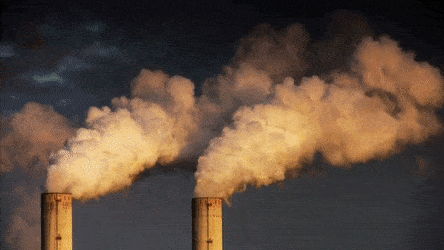AIR POLLUTION
- We are dependent on air for our respiratory needs.
- Air pollutants cause injury to all living organisms.
- They reduce growth and yield of crops and cause premature death of plants.
- Air pollutants also deleteriously affect the respiratory system of humans and of animals.
- Harmful effects depend on the concentration of pollutants, duration of exposure and the organism.
- Smokestacks of thermal power plants, smelters and other industries release particulate and gaseous air pollutants together with harmless gases, such as nitrogen, oxygen, etc.
- These pollutants must be separated/ filtered out before releasing the harmless gases into the atmosphere.
- Electrostatic precipitator There are several ways of removing particulate matter; the most widely used of which is the electrostatic precipitator, which can remove over 99 per cent particulate matter present in the exhaust from a thermal power plant.
- It has electrode wires that are maintained at several thousand volts, which produce a corona that releases electrons.
- These electrons attach to dust particles giving them a net negative charge.
- The collecting plates are grounded and attract the charged dust particles.
- The velocity of air between the plates must be low enough to allow the
dust to fall.
- A scrubber can remove gases like sulphur dioxide.
- In a scrubber, the exhaust is passed through a spray of water or lime.
- Recently we have realised the dangers of particulate matter that are very very small and are not removed by these precipitators.
- According to Central Pollution Control Board (CPCB), particulate size 2.5 micrometers or less in diameter (PM 2.5) are responsible for causing the greatest harm to human health.
- These fine particulates can be inhaled deep into the lungs and can cause breathing and respiratory symptoms, irritation, inflammations and damage to the lungs and premature deaths.
- Automobiles are a major cause for atmospheric pollution at least in the metro cities.
- As the number of vehicles increase on the streets, this problem is now shifting to the other cities too.
- Proper maintenance of automobiles along with use of lead-free petrol or diesel can reduce the pollutants they emit.
- Catalytic converters, having expensive metals namely platinum-palladium and rhodium as the catalysts, are fitted into automobiles for reducing emission of poisonous gases.
- As the exhaust passes through the catalytic converter, unburnt hydrocarbons are converted into carbon dioxide and water, and carbon monoxide and nitric oxide are changed to carbon dioxide and nitrogen gas, respectively.
- Motor
vehicles equipped with catalytic converter should use unleaded petrol
because lead in the petrol inactivates the catalyst


Comments
Post a Comment